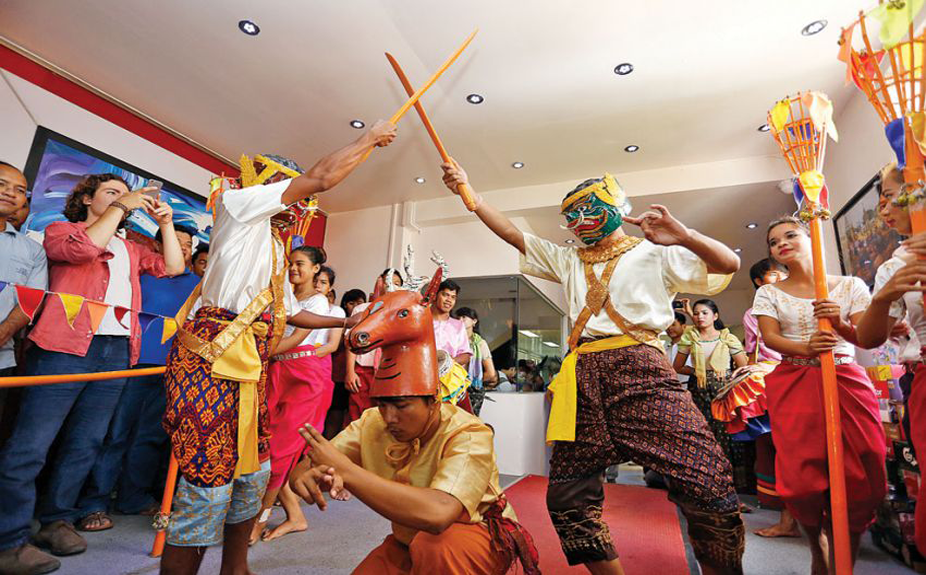Robam Trot (Folk Dance)
 In recent years Trot Dance or Khmer Folk dance called “Robam Trot” is becoming popular at the New Year festival to rid the people and performed in an ancient format believed to ward off bad luck from the previous year, usually performed before and during Khmer New Year festival. It has been performed since ancient times in Cambodia’s provinces of Siem Reap and Battambang. Trot dancers dress in brightly colored costumes and go from house to house collection money and offerings from the community for the local temple. Hand drums and poles with bells attached to provide rhythm for the dance. The elaborate dance has several characters, including a Hunter, Oxen, Giant, and Witch who attempt to kill a deer while Peacock try to protect it.
In recent years Trot Dance or Khmer Folk dance called “Robam Trot” is becoming popular at the New Year festival to rid the people and performed in an ancient format believed to ward off bad luck from the previous year, usually performed before and during Khmer New Year festival. It has been performed since ancient times in Cambodia’s provinces of Siem Reap and Battambang. Trot dancers dress in brightly colored costumes and go from house to house collection money and offerings from the community for the local temple. Hand drums and poles with bells attached to provide rhythm for the dance. The elaborate dance has several characters, including a Hunter, Oxen, Giant, and Witch who attempt to kill a deer while Peacock try to protect it.
This dance was inherited from the people of Somrae, natives of Cambodia thousands of years ago. During the Angkor era, the people of Somrae performed this dance for the king at New Year celebrations. The dance represents the ending of the old year and brings good luck and prosperity for the king in the coming year.
Trot is connected to a belief that wild animals that come into the village bring bad luck and misfortune. They created Trot which showcase wild animals, allowing villagers to spray perfume, put on makeup, and tie knots
on the animals. Then they pray to the animals for good luck. This serves as prevention against bad luck when wild animals come into the village in the future.
There is also a belief that this dance symbolizes the prayer for rain. In this case, they prefer using the peacock tail to represent the sun. The people pray to the sun asking for rain for their farmlands.
Trot is related to two folktales, the first folktale is about a hunter once upon a time there was a hunter named Bun who lived with his wife name Ubma in Savchey district. One day, the hunter went to hunt as usual but he could not find a single animal. He thought that maybe the forest spirits prevented him from finding the animals, so he prepared an offering and prayer to spirits to help him find animals. Suddenly he came upon a golden deer with golden yellow fur and antlers made out of shiny precious stones. He then shot and killed the deer. Upon retrieving the animal, he realized how beautiful it was and decided to offer it to the king. The king was delighted with the gesture and granted the hunter a rank as the district head. Afterwards, Bun created the Trot dance as a remembrance by making offering to the spirit of the forest.
Another folktale is related to Buddhism. Before Buddha attained enlightenment, he first became a monk. As he was on his way, an evil appears as a golden deer blocks his path. Buddha started to pray to an angel. The angel came down and appeared as a hunter to kill the golden deer and accompanied Buddha on his way to becoming a monk.
The front performer holds a kangcha which is a pole about 2.5 meters in height with the top portion shaped like a fork. The tips of the head are tied together by a string and decorated with dry fruit balls (Angkugn) with metal pieces inside which make noise when the pole is thumb on the ground. This performer provides the beat to the music with other musicians who use drums and two Tro (Tro Ou and Tro Saur - type of instruments used in classical Khmer music).